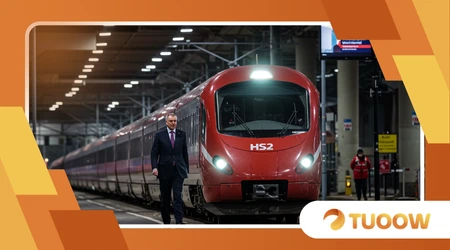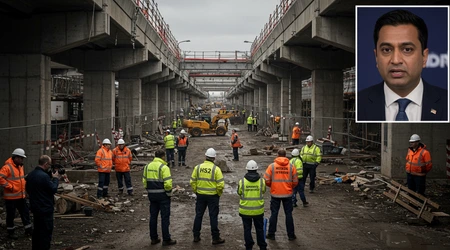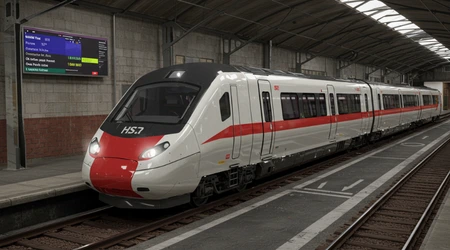HS2 Project in Turmoil: Transport Secretary Calls It an ‘Appalling Mess

The HS2 Project in Turmoil has become a lightning rod for controversy, with Transport Secretary Heidi Alexander branding it an “appalling mess” in a scathing June 2025 parliamentary address.
What was once heralded as Britain’s bold leap into high-speed rail a transformative link between London, Birmingham, and beyond now stumbles under the weight of spiralling costs, delays, and political finger-pointing.
Initially pitched in 2010 with a £30 billion price tag, the project’s costs have ballooned to over £100 billion, with no clear completion date in sight.
This article unpacks the chaos, explores the root causes, and questions whether HS2 can still deliver on its promise of revolutionising UK transport. Why has a project meant to connect the nation become a symbol of division and dysfunction?
The saga of HS2 is not just a story of engineering ambition but a cautionary tale of governance failures. From ministerial oversight lapses to inflated contracts, the project has been plagued by systemic issues.
Yet, amidst the criticism, there are glimmers of hope new leadership, a reset plan, and a commitment to learning from past mistakes.
This piece will delve into the complexities of the HS2 Project in Turmoil, offering a clear-eyed view of its challenges, implications, and potential redemption.
Let’s explore how a dream of high-speed connectivity became a national headache and what it means for Britain’s infrastructure future.
The Rise and Fall of HS2’s Grand Vision
Conceived in 2010, HS2 aimed to slash travel times between London, Birmingham, Manchester, and Leeds. The vision was bold: a Y-shaped network easing rail congestion.
Yet, the HS2 Project in Turmoil began almost immediately. Costs doubled, then tripled, as political indecision reshaped plans.
The northern legs to Manchester and Leeds were axed by the Conservative government before July 2025, leaving only the London-Birmingham stretch. This truncation gutted the project’s original promise, turning a national network into a regional line.
Public trust eroded as costs soared past £100 billion. Residents in places like Wendover faced endless construction disruption, with little tangible benefit.
++ Labour Rebellion: Inside MPs’ Pushback Against Welfare Reform
A mile-long “green tunnel” in the Chilterns, meant to blend into the landscape, became a symbol of excess. Locals dubbed it a “nuclear bunker,” questioning its value.
The HS2 Project in Turmoil reflects not just financial mismanagement but a disconnect between planners and communities.
The human cost is palpable. In Birmingham, construction workers toil under uncertainty, while taxpayers foot the bill for delays.
The project’s scope changes driven by political whims have left communities disillusioned. Can a railway, however fast, justify such upheaval when its benefits feel so distant?

Mismanagement at the Heart of the Crisis
Transport Secretary Heidi Alexander’s June 2025 statement laid bare HS2’s failures. An interim report by HS2 Ltd CEO Mark Wild exposed “shocking mismanagement.”
Contracts were signed without proper oversight, and £2 billion was spent on scrapped northern legs. The HS2 Project in Turmoil stems from a chaotic hierarchy, with HS2 Ltd, the Department for Transport, and contractors misaligned.
The James Stewart Review, commissioned in December 2024, issued 89 recommendations to curb waste. It highlighted “ineffective contracts” and a lack of ministerial scrutiny.
For example, a £250 million Euston station redesign ballooned costs further. Alexander accused the Conservatives of wasting billions through indecision, a charge shadow minister Gareth Bacon partly conceded.
Fraud allegations added fuel to the fire. Whistleblowers reported inflated staffing rates in the supply chain, undermining trust.
The HS2 Project in Turmoil isn’t just about money it’s about a failure of accountability. New leadership, including Mike Brown as HS2 Ltd Chair, aims to reset the project, but can they rebuild trust?
The review’s findings are a wake-up call. Poor financial controls and a “bureaucratic” HS2 Ltd structure hindered progress. Mark Wild’s letter to Alexander stressed delivering at the “lowest feasible cost.”
Yet, with costs already astronomical, taxpayers deserve clarity on what they’re funding.
The Infamous Bat Tunnel: A Case Study in Excess
Nothing encapsulates the HS2 Project in Turmoil like the £125 million “bat tunnel” near Birmingham. Designed to protect a rare bat species, its cost doubled due to inflation and poor planning.
Labour MP Luke Charters called it “ludicrous,” warning of further cost hikes. This tunnel, meant to shield wildlife, has become a lightning rod for criticism.
Consider the optics: £125 million for a bat tunnel while schools and hospitals beg for funding. It’s like building a gold-plated bridge for a single pedestrian.
The tunnel’s cost reflects HS2’s broader issues prioritising niche concerns over fiscal restraint. Critics argue the money could upgrade existing rail lines, benefiting millions.
Public frustration is mounting. Social media posts on X in June 2025 called the tunnel a “wasteful farce.” Yet, HS2 defends it, citing environmental obligations.
Read more: Blaise Metreweli Appointed as MI6’s First Female Chief in 116-Year History
The HS2 Project in Turmoil highlights a tension between green goals and economic reality. Can infrastructure projects balance both without breaking the bank?
The bat tunnel saga isn’t isolated. A £200 million bat shed near Water Orton sparked similar outrage. These examples show how HS2’s scope creep inflates costs.
The government must now weigh environmental mandates against public tolerance for spending.
A Path Forward or a Sinking Ship?
Heidi Alexander vows to “sort out” the HS2 Project in Turmoil, but the path is steep. The government has allocated £25 billion in the recent Spending Review to stabilise HS2.
New leadership, including Mark Wild and Mike Brown, brings experience from Crossrail, a project that overcame similar woes. But with no revised completion date, uncertainty lingers.
The Stewart Review’s 89 recommendations offer a roadmap. Renegotiating contracts and tightening oversight are priorities.
Yet, critics like Reform UK’s Nigel Farage argue for scrapping HS2 entirely, calling it a “£100 billion white elephant.” Public sentiment, especially in affected areas, leans toward scepticism.
Progress exists Old Oak Common station’s first platform was unveiled in May 2025. But slower train speeds may be needed to avoid lengthy testing, per a Financial Times report.
The HS2 Project in Turmoil faces a stark choice: reset or retreat. Can Labour deliver where others failed?
The government’s broader infrastructure push adds pressure. Projects like Northern Powerhouse Rail depend on HS2’s lessons.
Alexander’s pledge to learn from mistakes is promising, but execution is key. Taxpayers need results, not rhetoric, to justify the investment.
The Broader Implications for UK Infrastructure
The HS2 Project in Turmoil is a microcosm of Britain’s infrastructure woes. The Council on Geostrategy’s 2025 report, Road to Nowhere, calls HS2 a symbol of systemic delivery failures.
Since 2010, costs have risen fivefold, with phase one alone now exceeding £100 billion. This statistic underscores the challenge of balancing ambition with accountability.
| HS2 Cost Escalation (2010-2025) | Amount (£ Billion) |
|---|---|
| Original Estimate (2010) | 30 |
| Revised Estimate (2013) | 37.5 |
| Current Estimate (2025) | 100+ |
Other projects, like the Lower Thames Crossing, risk similar fates without reform. The HS2 Project in Turmoil exposes a need for stricter project guidelines. Political indecision, as seen in HS2’s scope changes, must end to restore confidence.
Public perception is shifting. X posts in June 2025 described HS2 as a “national embarrassment.”
The government’s infrastructure strategy, released on 19 June 2025, hinges on fixing HS2’s flaws. Labour’s commitment to economic growth through infrastructure demands tangible progress.
The stakes are high. HS2’s failure could deter future investment in rail. Conversely, success could redefine Britain’s transport landscape. The question remains: can the government turn a troubled project into a triumph?
Learning from HS2: A Blueprint for the Future

The HS2 Project in Turmoil offers hard lessons for UK infrastructure. The James Stewart Review’s call for better oversight must guide projects like Northern Powerhouse Rail.
Consistent ministerial attendance at oversight meetings is non-negotiable. HS2’s ministerial taskforce suffered from absenteeism, costing billions.
Imagine a small business owner, like Sarah from Birmingham, watching her taxes fund HS2’s delays. She asks, “Why can’t they manage projects like I manage my shop?”
It’s a fair question. Efficient businesses thrive on clear goals and accountability principles HS2 lacked.
Contract reform is critical. HS2 Ltd’s “ineffective contracts” placed undue risk on the delivery body. Future projects need balanced risk-sharing to avoid cost overruns. The HS2 Project in Turmoil is a chance to rethink how Britain builds.
Finally, public engagement must improve. Communities like Wendover deserve transparent communication.
HS2’s reset plan, backed by £25 billion, could set a precedent for accountability. Will Labour seize this opportunity to redefine infrastructure delivery?
Conclusion: Can HS2 Rise from the Ashes?
The HS2 Project in Turmoil stands at a crossroads. Once a beacon of progress, it now grapples with a legacy of mismanagement and mistrust.
Heidi Alexander’s bold reset plan, underpinned by new leadership and the James Stewart Review’s 89 recommendations, offers hope.
Yet, the project’s £100 billion-plus price tag and indefinite delays fuel scepticism. The bat tunnel and scrapped northern legs are stark reminders of what happens when ambition outpaces oversight.
Britain’s infrastructure future hangs in the balance. HS2’s lessons could shape projects like Northern Powerhouse Rail, ensuring they deliver value.
Taxpayers, like Sarah, deserve a railway that works not a symbol of waste. The government’s £25 billion commitment signals intent, but only results will rebuild trust.
Can HS2 become the high-speed success story it was meant to be, or will it remain a cautionary tale? The answer lies in Labour’s ability to turn words into action.
Frequently Asked Questions
Why is the HS2 project so expensive?
Costs escalated due to mismanagement, scope changes, and ineffective contracts. The James Stewart Review highlighted £2 billion wasted on scrapped northern legs.
Will HS2 ever be completed?
Transport Secretary Heidi Alexander has committed to a reset plan, but no new completion date exists beyond 2033, making completion uncertain but possible.
